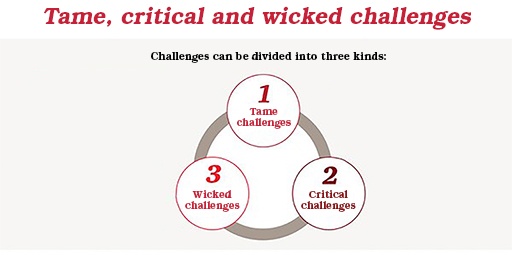1.3 Step 3: Types of leadership challenges: tame, wicked and critical challenges
You may have come across the idea of tame, wicked and critical challenges before. The terminology ‘challenges’ is used here to emphasise that leaders can face opportunities as well as problems. In both instances you need to be able to categorise the challenge to know how it can be tackled most effectively.
Tame challenges are solvable, they are likely to have been solved by someone before. They can be complicated but they have a solution. They are the sort of challenges that need a technical, scientific or highly skilled response. Keith Grint, Emeritus Professor of Public Leadership at Warwick University, gives the examples of: timetabling the railways, building a nuclear plant, training the army, planned heart surgery or wage negotiations (Grint, 2010, p. 169). His advice to leaders facing tame challenges is to find an individual or group who have successfully solved the challenge before and delegate the task to them.
Wicked challenges are not just complicated but complex. They are normally caused by many different factors in the environment. There is no clear relationship between cause and effect but many different elements lead to the problematic situation. Because of this the challenges are uncertain and may never be fully solved – for example, high levels of crime are caused by a complex interaction between culture, societal pressures, economic policies, housing, criminal justice policies, education, social care and health and well-being. Tackling one of these issues will not solve the challenge of high crime rates and it is questionable whether it will ever be solved in terms of a society achieving a zero crime rate.
Grint says these challenges need to be addressed collaboratively. He makes the point that, in business, people often want leaders who quickly come to a decision about a course of action. But, according to Grint, wicked challenges require the transfer of authority from individual to collective because only collective engagement can hope to address the challenge.
The uncertainty involved in Wicked Challenges imply that leadership, as I am defining it, is not a science but an art – the art of engaging a community in facing up to complex collective problems.
One of the key skills of addressing these types of challenges is to be able to ask the ‘right’ questions, not give the right answers. By this he means open, probing questions that get to the heart of the issues and encourage people to work together on possible solutions.
Grint’s third category is critical challenges. Critical challenges are crises. They need urgent action. The leader acts as a commander and dictates the response to the situation. Authoritarian leaders can create a sense of crisis so that their solution will be readily accepted by their followers.
The following activity will help you explore the difference between tame, wicked and critical challenges.
Activity 3 Categorising leadership challenges
Read the brief description of each of the challenges below and, in the second column decide whether it is a tame, wicked or critical challenge.
The challenges Family faces have been included in the activity as examples.
Feedback
Challenge 1: responding to the challenge of flooding is a critical challenge as the urgency of the issue dictates what can be done about it. The leader or leaders need to take command and dictate the response to the challenge. However, you might remember Amanda’s advice in Video 2 about identifying the drivers of the challenge. In this case, responding to the immediate challenge is likely to create a revolving door where the challenge re-occurs in the future, so there is almost certainly a tame or wicked challenge affecting the crisis.
Challenge 2: Family’s challenge in creating an organisation that works remotely is a tame challenge even though it is complex. There are other organisations that have successfully addressed this challenge. So the response should be to delegate responding to the challenge to an individual or group who can find out how other organisations have approached the challenge.
Challenge 3: how to develop international guidance on preventing sexual violence to boys is a wicked challenge because the challenge has largely been ignored and there are complex drivers within societies that create the challenge. You may think parts of the challenge are more tame because there are organisations that are already tackling this issue. You might also remember Amanda’s advice in Video 2 about understanding the drivers of the situation. This challenge would require a collaborative approach involving different groups with an expertise and interest in the challenge. The main task for the leader is to ask questions about the challenge rather than to come up with solutions.
Challenge 4: using virtual reality as part of a university course is a tame challenge as other universities in other parts of the world have solved the challenge. The approach would be to delegate the challenge to a group or individual and task them with contacting other universities who have dealt with the challenge.
Challenge 5: the organisation that has lost one of its main contracts and will not be able to pay its staff in three months time faces a critical challenge. Action needs to be taken now so staff can be paid and the leader needs to act decisively. However, as with Challenge 1, there is almost certainly an underlying driver that caused this situation which may be a tame challenge, if other organisations have already solved it, or a wicked challenge.
In this section you have learned how to deal with different leadership challenges. However, when looking at leadership challenges in turbulent contexts, you cannot ignore the role of diversity and inclusiveness. It is this that you will look at next.

